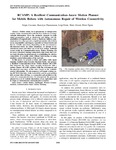RCAMP: A resilient communication-aware motion planner for mobile robots with autonomous repair of wireless connectivity
| dc.contributor.author | Caccamo, S | |
| dc.contributor.author | Parasuraman, R | |
| dc.contributor.author | Freda, L | |
| dc.contributor.author | Gianni, M | |
| dc.contributor.author | Ogren, P | |
| dc.date.accessioned | 2019-01-21T11:00:31Z | |
| dc.date.available | 2019-01-21T11:00:31Z | |
| dc.date.issued | 2017-09 | |
| dc.identifier.isbn | 9781538626825 | |
| dc.identifier.issn | 2153-0858 | |
| dc.identifier.issn | 2153-0866 | |
| dc.identifier.uri | http://hdl.handle.net/10026.1/13177 | |
| dc.description.abstract |
Mobile robots, be it autonomous or teleoperated, require stable communication with the base station to exchange valuable information. Given the stochastic elements in radio signal propagation, such as shadowing and fading, and the possibilities of unpredictable events or hardware failures, communication loss often presents a significant mission risk, both in terms of probability and impact, especially in Urban Search and Rescue (USAR) operations. Depending on the circumstances, disconnected robots are either abandoned, or attempt to autonomously back-trace their way to the base station. Although recent results in Communication-Aware Motion Planning can be used to effectively manage connectivity with robots, there are no results focusing on autonomously re-establishing the wireless connectivity of a mobile robot without back-tracing or using detailed a priori information of the network. In this paper, we present a robust and online radio signal mapping method using Gaussian Random Fields, and propose a Resilient Communication-Aware Motion Planner (RCAMP) that integrates the above signal mapping framework with a motion planner. RCAMP considers both the environment and the physical constraints of the robot, based on the available sensory information. We also propose a self-repair strategy using RCMAP, that takes both connectivity and the goal position into account when driving to a connection-safe position in the event of a communication loss. We demonstrate the proposed planner in a set of realistic simulations of an exploration task in single or multi-channel communication scenarios. | |
| dc.format.extent | 2010-2017 | |
| dc.language.iso | en | |
| dc.publisher | IEEE | |
| dc.rights | Attribution-NonCommercial-NoDerivatives 4.0 International | |
| dc.rights | Attribution-NonCommercial-NoDerivatives 4.0 International | |
| dc.rights | Attribution-NonCommercial-NoDerivatives 4.0 International | |
| dc.rights | Attribution-NonCommercial-NoDerivatives 4.0 International | |
| dc.rights | Attribution-NonCommercial-NoDerivatives 4.0 International | |
| dc.rights | Attribution-NonCommercial-NoDerivatives 4.0 International | |
| dc.rights | Attribution-NonCommercial-NoDerivatives 4.0 International | |
| dc.rights | Attribution-NonCommercial-NoDerivatives 4.0 International | |
| dc.rights | Attribution-NonCommercial-NoDerivatives 4.0 International | |
| dc.rights.uri | http://creativecommons.org/licenses/by-nc-nd/4.0/ | |
| dc.rights.uri | http://creativecommons.org/licenses/by-nc-nd/4.0/ | |
| dc.rights.uri | http://creativecommons.org/licenses/by-nc-nd/4.0/ | |
| dc.rights.uri | http://creativecommons.org/licenses/by-nc-nd/4.0/ | |
| dc.rights.uri | http://creativecommons.org/licenses/by-nc-nd/4.0/ | |
| dc.rights.uri | http://creativecommons.org/licenses/by-nc-nd/4.0/ | |
| dc.rights.uri | http://creativecommons.org/licenses/by-nc-nd/4.0/ | |
| dc.rights.uri | http://creativecommons.org/licenses/by-nc-nd/4.0/ | |
| dc.rights.uri | http://creativecommons.org/licenses/by-nc-nd/4.0/ | |
| dc.subject | Mobile Robots | |
| dc.subject | Self-Repair | |
| dc.subject | Wireless Communication | |
| dc.subject | Communication-Aware Motion Planning | |
| dc.title | RCAMP: A resilient communication-aware motion planner for mobile robots with autonomous repair of wireless connectivity | |
| dc.type | conference | |
| dc.type | Proceedings Paper | |
| plymouth.author-url | https://www.webofscience.com/api/gateway?GWVersion=2&SrcApp=PARTNER_APP&SrcAuth=LinksAMR&KeyUT=WOS:000426978202045&DestLinkType=FullRecord&DestApp=ALL_WOS&UsrCustomerID=11bb513d99f797142bcfeffcc58ea008 | |
| plymouth.date-start | 2017-09-24 | |
| plymouth.date-finish | 2017-09-28 | |
| plymouth.volume | 2017-September | |
| plymouth.conference-name | 2017 IEEE/RSJ International Conference on Intelligent Robots and Systems (IROS) | |
| plymouth.publication-status | Published | |
| plymouth.journal | 2017 IEEE/RSJ International Conference on Intelligent Robots and Systems (IROS) | |
| dc.identifier.doi | 10.1109/iros.2017.8206020 | |
| plymouth.organisational-group | /Plymouth | |
| plymouth.organisational-group | /Plymouth/Faculty of Science and Engineering | |
| plymouth.organisational-group | /Plymouth/Faculty of Science and Engineering/School of Engineering, Computing and Mathematics | |
| plymouth.organisational-group | /Plymouth/REF 2021 Researchers by UoA | |
| plymouth.organisational-group | /Plymouth/REF 2021 Researchers by UoA/UoA11 Computer Science and Informatics | |
| plymouth.organisational-group | /Plymouth/Users by role | |
| plymouth.organisational-group | /Plymouth/Users by role/Academics | |
| dc.identifier.eissn | 2153-0866 | |
| dc.rights.embargoperiod | Not known | |
| rioxxterms.versionofrecord | 10.1109/iros.2017.8206020 | |
| rioxxterms.licenseref.uri | http://creativecommons.org/licenses/by-nc-nd/4.0/ | |
| rioxxterms.type | Conference Paper/Proceeding/Abstract |



